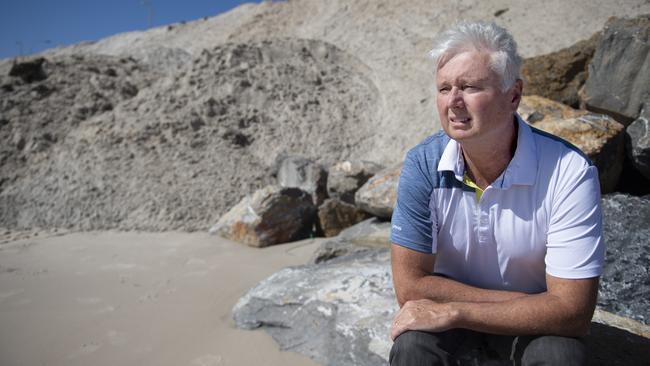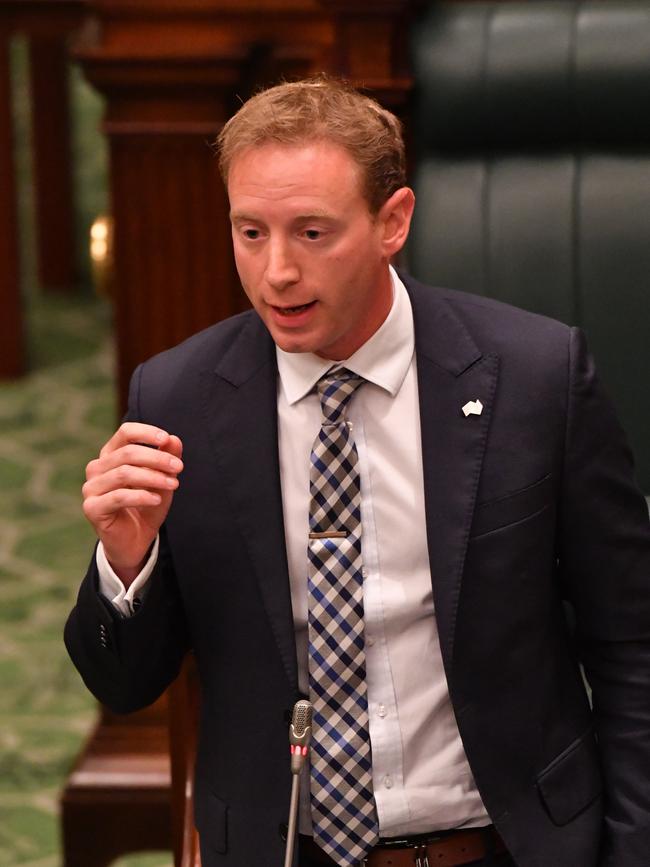Coastal erosion threatens to reduce Adelaide seaside to series of ‘pocket beaches’
Sand is rapidly slipping from Adelaide’s beaches amid warnings the coast could be reduced to three ‘pocket beaches’ without a new plan to save them.

SA News
Don't miss out on the headlines from SA News. Followed categories will be added to My News.
READ BELOW: Saving beaches needs serious money: Minister
- Stark warning for the future of Adelaide’s beaches
- Groyne to reduce sand drift trialed at Brighton
- Why this Adelaide beach has been lined with fences
Sand is slipping away from Adelaide’s coastline at an alarming rate, forcing authorities to rethink strategies to preserve our suburban beaches.
The sad demise of West Beach — where the local surf club fears its clubroom might collapse — is a sign of things to come, as coastal erosion outstrips efforts to restore the damage.
Adelaide’s beach system runs 28km, from Kingston Park in the south to Outer Harbor in the north, and it’s a simple fact that sand naturally moves northwards.
In the past, Adelaide beaches were backed by an extensive dune system, so there was plenty of sand to go around. But development changed all of that and now the days of the sandy beach are numbered.
In 2016, coastal geologist Dr Ian Dyson warned that Adelaide’s beaches were at risk of disappearing within a decade, leaving just three 400m-long “pocket” beaches — Glenelg, Henley Beach and Semaphore, with breakwater at either end.
He said the rest of the coastline would become a rocky foreshore, like Hallett Cove, lined by sea walls.
Since then, he says “nothing much has changed”. We’re just closer to seeing the prophesy fulfilled. “It’s what you see typically in Europe,” he says.

“Sand replenishment is very expensive, and for the Adelaide metro beaches, the Government might decide it’s just too expensive. Then you go from coast protection to property protection and put huge bluestone boulders in front of the remnants of coastal dunes.”
Dr Dyson says the State Government’s 20-year Adelaide Living Beaches Strategy(2005-25), which involves sand pumping and carting, has failed.
His plan for our beaches includes groynes, constructed of sand-filled geo-textile bags jutting out from the coastline at just below the high water level, to capture sand and minimise loss, making pumping and carting more effective. Surveyor John Dundon, of West Beach, is furious about the failed policy and decades of “sand mining” at the Torrens Outlet.
As director of Australian Construction Surveys, he has put his skills to good use, using Freedom of Information laws to obtain data on the source and amounts of sand removed and redistributed along the coast.
He also devoured hundreds of pages of Government documents, including a report by external consultants Danish Hydraulics Institute (DHI).
His analysis of the data shows more than a million cubic metres of sand was taken from the Torrens Outlet (“mined” or “harvested” depending on who you are talking to) between 1997 and 2016.
Of that, about 630,000 cubic metres went to West Beach Parks to top up the dunes.
The rest, about 390,000 cubic metres, went to other beaches including Glenelg North, Somerton Park, Seacliff, Brighton North and Henley Beach South.
But the data also shows it hasn’t worked for West Beach because that sand didn’t stick.
“Digging out this end and putting it at the other end and not all of it, some of it, hasn’t helped at all and we’ve still lost the entire amount they dug out,” Mr Dundon says. “That’s what this is saying, it’s proven in the survey data. The message is don’t mine the outlet, it destroys West Beach.”
It seems the Government is finally getting the message.

State Environment Minister David Speirs says the sand pipeline from the Torrens Outlet to West Beach Dunes is no longer being used because it is like “robbing Peter to pay Paul”.
“Ideally the pipeline should be extended, because then we could get those very large deposits that naturally end up in the northern beaches down to West Beach,” he says.
“If we did that, combined with additional injection of sand into the West Beach and Henley South area, similar to what they did around Seacliff and South Brighton, you could rebuild the sand dunes and it would sort the problem, but it obviously would cost a lot of money.” Charles Sturt Council chief executive Paul Sutton says it’s clear current strategies have not been successful in maintaining a healthy beach and dune system in the region.
He says the DHI study suggests about 1.5 million cubic metres of sand is required to replenish West Beach.
“The City of Charles Sturt beach maintenance teams have been monitoring the situation and have continued to report that the Coastal Protection Board’s 80 cubic metre buffer has not been able to be maintained effectively in the West Beach dunes,” he says.
“The stone wall separating the top of the dunes and the path is now in a critical state … and if further erosion occurs is likely to collapse.”
He fears winter will be worse, with more challenging wave movement and storms further eroding the dunes, which should be preserved for generations to come.
The other coastal councils of Port Adelaide Enfield, the Holdfast Bay and Marion were approached for comment but did not respond by deadline.
Saving beaches needs serious money: Minister
Sand erosion at West Beach has prompted the State Government to consider finishing the sand-pumping pipeline the former Government failed to complete, at an extra cost of up to $25 million.
The 20-year Adelaide Living Beaches Strategy (2005-2025) was based on a sand pipeline running along the entire metropolitan coast. But the money ran out and only two sections were built, at a cost of $23 million.

The southern one between Glenelg and Kingston Park is operating, pumping 100,000 cubic metres of sand a year.
The other at West Beach is not, because it’s too short. That fact emerged when pipelines exposed after recent storm surges were left dangling mid-air as the rock wall subsided.
State Environment Minister David Speirs said the last big injection of sand was under the Olsen Government in the late 90s and early 2000s.
“We are lucky to have some amazing beaches and we need to protect those for future generations,” Minister Speirs said.
“For far too long our coastline hasn’t received the attention it deserves and the Marshall Liberal Government has put a renewed focus on our precious beaches.”
As a short-term fix, the Government is spending $1 million over two years to replenish the West Beach Parks dunes with sand trucked in from the Semaphore South breakwater. This is on top of the annual budget for the management of Adelaide’s beaches, around $6 million, mainly for sand trucking, pumping and management of the Glenelg and West Beach harbours.
But Mr Speirs believes the section of pipeline from Semaphore to West Beach that was not delivered should be funded, even if it is expensive.
“We are talking serious money if we are serious about sustaining those northern beaches,” he said. “It does need to be done in the next few years, there is no doubt, if we want to get this done properly and sustain the beaches.”
Having lived at West Beach since 1989, surveyor John Dundon knows the coast better than most. He founded the Save West Beach Sand facebook group and is campaigning for better coastal protection policy, fearing for the future of the entire coast.
“The whole thing is sick,” he said. “Glenelg North is a shocker, it’s bare rocks at low tide. And Henley South.”
Sandy beaches to rock shores
■ Longshore drift is the natural movement of sand along our coastline, from south to north.
■ In a healthy ecosystem, coastal sand dunes provide a buffer against the wind and waves.
■ But we built over the coastal dunes with roads, houses and other infrastructure then constructed sea walls to keep the ocean at bay.
■ We poisoned and smothered seaweed with sewage outfalls and wastewater run-off, causing more sand to be lost from our coastline.
■ We built boat ramps and jetties, harbours and marinas, further disrupting the natural flow of sand then tried to compensate with breakwaters and rock walls.
■ Since 1973, state governments have been working with local councils to replace lost sand on our beaches.

■ The 20-year Adelaide Living Beaches Strategy (2005-25) divided our 28km-long metropolitan beach into discrete sections or “cells”, with sand cycling within each cell.
■ Sand-pumping infrastructure proposed for the entire coast cost too much, so only two sections of pipe were installed.
■ Now only one is being used.
Trucks cart sand elsewhere.
■ Sand is recycled and brought back from north to the south, or brought in from elsewhere, dredging pockets of suitable sand offshore or inland.
■ But more sand is lost from our beaches than replaced.
■ Climate change means we need even more sand to have a hope of keeping our beaches.



